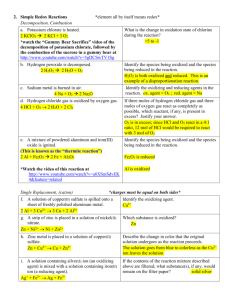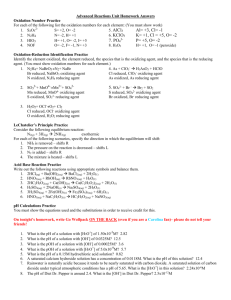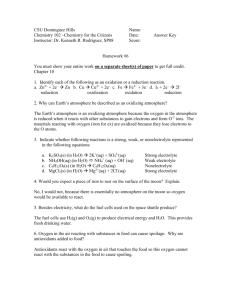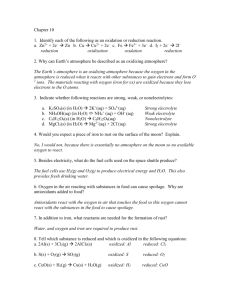RedOxLab
advertisement
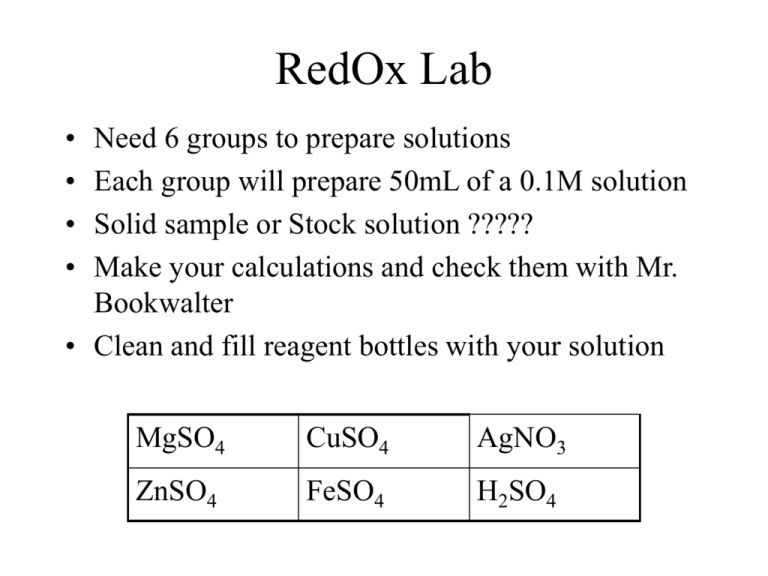
RedOx Lab • • • • Need 6 groups to prepare solutions Each group will prepare 50mL of a 0.1M solution Solid sample or Stock solution ????? Make your calculations and check them with Mr. Bookwalter • Clean and fill reagent bottles with your solution MgSO4 CuSO4 AgNO3 ZnSO4 FeSO4 H2SO4 Results – Bookwalter NR Gas NR NR NR NR Gas NR Gas NR NR NR NR NR RedOx reactions (Single Replacement) 0 0 +2 -2 2 Mg (s) + O2 (g) 2 MgO (s) Mg = oxidized more positive (reducing agent) O2 = reduced more negative (oxidizing agent) Oxidation of Metals by Acids and Salts 0 +1 +2 0 Zn (s) + 2 HCl (aq) ZnCl2 (aq) + H2 (g) Zn = oxidized more positive (reducing agent) H = reduced more negative (oxidizing agent) Oxidation of Metals by Acids and Salts +1 0 +2 0 H2SO4 (aq) + Fe (s) FeSO4 (aq) + H2 (g) Fe = oxidized more positive (reducing agent) H = reduced more negative (oxidizing agent) Oxidation of Metals by Acids and Salts Ni(NO3)2 (aq) + Fe (s) Ni (s) + Fe(NO3)2 (aq) Net Ionic: +2 0 0 +2 Ni+2 (aq) + Fe (s) Ni (s) + Fe+2 (aq) Fe = oxidized more positive (reducing agent) Ni = reduced more negative (oxidizing agent) Activity Series • Use to predict if a reaction will occur • Single Replacement • Any metal can be OXIDIZED by any metal below it on the series Examples Cu (s) + 2AgNO3 (aq) Cu(NO3)2 Net Ionic: 0 +1 +2 (aq) + 2 Ag (s) 0 Cu (s) + 2Ag+1(aq) Cu+2 (aq) + 2Ag(s) Cu = oxidized more positive (reducing agent) Ag = reduced more negative (oxidizing agent) Examples Cu (s) + 2FeNO3 (aq) No Reaction Based on the Activity Series Cu can’t be oxidized by Fe Meaning that Cu is below Fe on the activity series Examples Ni (s) + 2 HCl (aq) NiCl2 Net Ionic: 0 +1 +2 (aq) + H2 (g) 0 Ni (s) + 2H+1(aq) Ni+2 (aq) + H2 (g) Ni = oxidized more positive (reducing agent) H = reduced more negative (oxidizing agent) Types of RedOx reactions • Single replacement in acid – Mg(s) + HCl(aq) • Single replacement in H2O – Ca(s) + H2O(l) • Single replacement in aqueous salt – Cu(s) + AgNO3(aq) • Single replacement of nonmetals – F2(g) + LiBr(aq) E. Solution Stoichiometry and Titrations • 1. Stoichiometry Ex. How many grams of H2O form when 25.0 mL of 0.100M HNO3 is neutralized by NaOH? 0.100 mole HNO3 0.025 L = 2.5 x 10-3 mole HNO3 L 2.5 x 10-3 mole X grams = 0.045 grams H2O HNO3(aq) + NaOH (aq) H2O(l) + NaNO3 (aq) 1 mole 1 mole 18 grams 2. Titrations • Use a known standard solution to react with an unknown concentration of solution. • Equivalence point = same # of moles of each reactant • Indicator = a chemical that determines the end point of reaction (Ie. Equivalence point) – The indicator will change color – Phenolphtalein: CLEAR = ACID RED = BASE The end point is neutralized!!!


